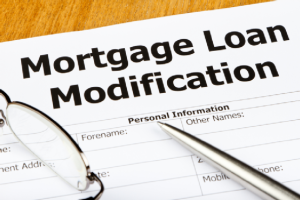By: Michael Powers
 By this date, most of the homeowners who got stuck in bad loans during the mid 2000’s have had some experience with the loan modification process. Although millions of Americans have been able to remedy their mortgages with loan modifications, there are millions more Americans that have been put through the wringer with loan modification attempts and remain in their troubled mortgages. So, why is it that loan modification has worked for some and not for others?
By this date, most of the homeowners who got stuck in bad loans during the mid 2000’s have had some experience with the loan modification process. Although millions of Americans have been able to remedy their mortgages with loan modifications, there are millions more Americans that have been put through the wringer with loan modification attempts and remain in their troubled mortgages. So, why is it that loan modification has worked for some and not for others?
The problem with loan modifications has always been that there was never any consistency to qualifying. Sure, the mathematical formulas were always relatively the same, but there were always exceptions that could trump those formulas.
 Let’s create an example of two homeowners with similar income and expenses. Let’s say that each homeowner had a qualifying hardship, which made their payments unaffordable. Let’s say that each had a mortgage payment that had become 45% of their household income. Let’s also say that each one of them was in an adjustable rate loan with a current interest rate of 9%. Lastly, let’s say that both of the loans were being serviced by Bank of America, and that each homeowner submitted an RMA (Request for Mortgage Assistance). Chances are, they would have the same outcome for a loan modification application, right? Absolutely not.
Let’s create an example of two homeowners with similar income and expenses. Let’s say that each homeowner had a qualifying hardship, which made their payments unaffordable. Let’s say that each had a mortgage payment that had become 45% of their household income. Let’s also say that each one of them was in an adjustable rate loan with a current interest rate of 9%. Lastly, let’s say that both of the loans were being serviced by Bank of America, and that each homeowner submitted an RMA (Request for Mortgage Assistance). Chances are, they would have the same outcome for a loan modification application, right? Absolutely not.
With the scenarios described, each of these homeowners would be ideal candidates for a loan modification. In fact, they would probably each qualify for the government program (HAMP), since that is usually a bank’s first choice due to the cash incentives for participation. Within the HAMP procedure, the interest rate could be reduced and the term lengthened to make the homeowner’s payment roughly 33% of their income, and the adjustable rate could be changed to a reasonable, fixed interest rate. Even if the numbers we created were less favorable and fell outside the HAMP guidelines, all of the large banks and servicers have “in-house”, proprietary programs that have less stringent requirements, and serve as backups for homeowners that slip through the HAMP qualification net.
This all sounds relatively simple, right? Well, at this point, the whole outcome depends on one factor; does a loan modification serve the best financial interest for each of the investors?
 Let’s go back to those two homeowners with the exact same set of qualifications. Now let’s say that one of them had private mortgage insurance (PMI). In this scenario, it is quite possible that a default and foreclosure on that property would be far more profitable to the investor than the homeowner staying current on the loan, let alone being given a loan modification. Since participation in any loan modification program is voluntary, this investor could deny all requests for a loan modification and foreclose on the property, presuming it was in default. They could then cash in on the mortgage insurance claim and sell the property, realizing a huge profit from the whole transaction. Let’s also say that the other homeowner did not have PMI, and their house was worth less than the mortgage amount. For the note holder of that loan, it would make more sense to keep the homeowner in the home and continue to collect payments, even at a reduced amount. If that note holder had to foreclose and resell the property, without being able to cash in on a mortgage insurance policy, a substantial amount of money would be lost. And so, it is easy to see why two homeowners of equal qualifications, applying for the same loan modification programs could have completely different results.
Let’s go back to those two homeowners with the exact same set of qualifications. Now let’s say that one of them had private mortgage insurance (PMI). In this scenario, it is quite possible that a default and foreclosure on that property would be far more profitable to the investor than the homeowner staying current on the loan, let alone being given a loan modification. Since participation in any loan modification program is voluntary, this investor could deny all requests for a loan modification and foreclose on the property, presuming it was in default. They could then cash in on the mortgage insurance claim and sell the property, realizing a huge profit from the whole transaction. Let’s also say that the other homeowner did not have PMI, and their house was worth less than the mortgage amount. For the note holder of that loan, it would make more sense to keep the homeowner in the home and continue to collect payments, even at a reduced amount. If that note holder had to foreclose and resell the property, without being able to cash in on a mortgage insurance policy, a substantial amount of money would be lost. And so, it is easy to see why two homeowners of equal qualifications, applying for the same loan modification programs could have completely different results.
THE UNTOLD STORY
 For some lenders, this was all part of their business plan. They wrote loans that had terms which would eventually make the mortgage unaffordable (predatory loans), with the idea that a default would be inevitable. Then they required the borrower to carry PMI before they would issue the loan. This plan ultimately lead to thousands upon thousands of mortgage defaults that ended in a foreclosure and mortgage insurance claim, and the net profits realized by the lender were astronomical.
For some lenders, this was all part of their business plan. They wrote loans that had terms which would eventually make the mortgage unaffordable (predatory loans), with the idea that a default would be inevitable. Then they required the borrower to carry PMI before they would issue the loan. This plan ultimately lead to thousands upon thousands of mortgage defaults that ended in a foreclosure and mortgage insurance claim, and the net profits realized by the lender were astronomical.
This precise scenario has already happened millions of times here in America, often with the assistance of the servicer. You see, over the past 7 or so years, many homeowners were convinced by their servicers that the only way to qualify for a loan modification was to become delinquent on their mortgage. Accordingly, many homeowners were led astray and intentionally stopped making their payments, thinking it would benefit them in the long run by qualifying them for a loan modification. For some of those homeowners, the intentional default strategy was successful. For others, it cost them their home.
 It is for these reason that hiring an attorney to resolve your troubled mortgage is the wise choice. Experienced mortgage attorneys are familiar with available programs and potential pitfalls, and have the ability to deploy legal strategies that can stop a lender from using deceptive practices to take your home. In addition, there has been a great deal of new legislation regarding foreclosures and homeowners’ rights that attorneys are aware of and can use to your advantage. Your home is one of your most valuable assets. Hiring an experienced attorney to protect it just makes sense.
It is for these reason that hiring an attorney to resolve your troubled mortgage is the wise choice. Experienced mortgage attorneys are familiar with available programs and potential pitfalls, and have the ability to deploy legal strategies that can stop a lender from using deceptive practices to take your home. In addition, there has been a great deal of new legislation regarding foreclosures and homeowners’ rights that attorneys are aware of and can use to your advantage. Your home is one of your most valuable assets. Hiring an experienced attorney to protect it just makes sense.
